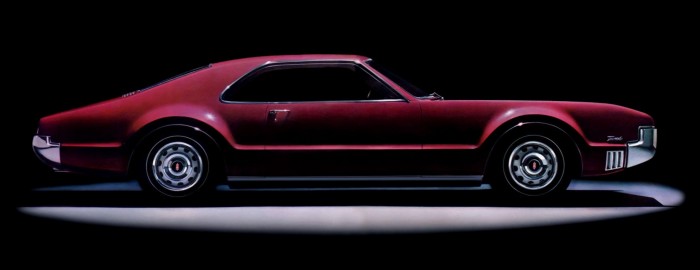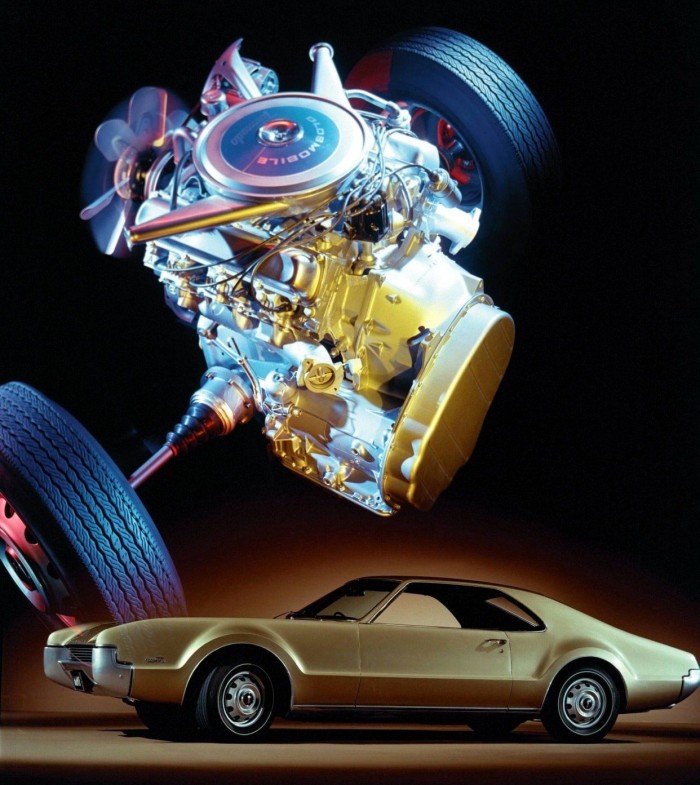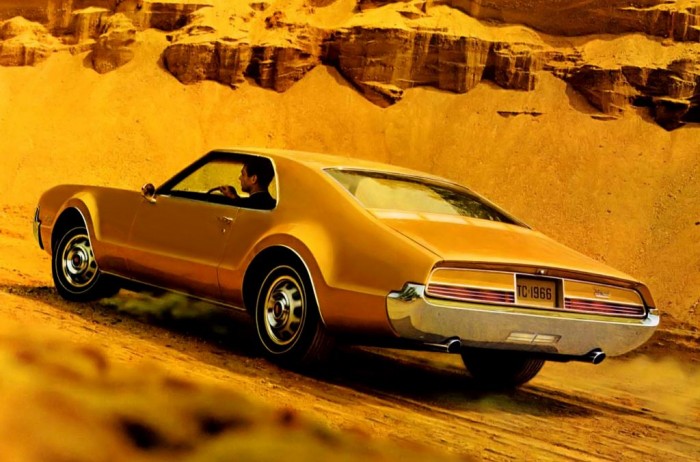Oldsmobile Toronado, GM’s most ground-breaking production car, turns 50
Posted on Feb 9, 2021 in Featured | 2 comments

In mid-Sixties America, front-wheel drive represented—at the same time—automotive past and future. Many others had tried it, but their efforts seemed relegated to the history books, with the last of the bunch 30 years gone. And yet the coming tide of imported cars included many a puller-type as well as pushers. It fell, then, to Oldsmobile to bridge the gap, something it did to much acclaim with the Toronado, introduced 50 years ago today.
The idea of a front-wheel-drive GM car dates back more than a decade, to the La Salle II Motorama dream car of 1955, according to Michael Lamm’s history of the Toronado from SIA #35. Staff at GM Engineering, not content with exploring just the L’Universelle approach to front-wheel-drive, conceived of the Unitized Power Package, a compact all-in-one (V-type engine, automatic transmission, and axle/differential) system that fit in the same space as just the engine in a typical rear-wheel-drive vehicle.
The UPP never made it into the La Salle II (even the dream car’s double overhead-camshaft V-6 engine never got past the mockup stage) but Oldsmobile—mainly through the advocacy of its assistant chief engineer, John Beltz—picked up UPP development in January 1958, likely as a response to rumors of Ford’s work on front-wheel-drive systems for the Thunderbird. Beltz and his staff initially envisioned the UPP for its F-85 compact and by 1960 built a running and driving experimental car based on the F-85’s wheelbase.

Oldsmobile’s development of the UPP began with a transverse V-6, but their own work—and corporate pressures—led them to eventually change the drivetrain layout to a longitudinal V-8 with a modified version of the Turbo Hydra-Matic 400 three-speed automatic turned 180 degrees and mounted alongside the engine, feeding power to a differential and torsion bar-sprung axles. While Oldsmobile’s engineers initially tried transferring power from the engine to the transmission via gears, the key to the success of the UPP, as they found out, was a single chain made of 2,294 pieces developed by Morse Chain and dubbed the Hy-Vo.
Like the engineering effort, the initial styling sketches for the Toronado began with a more compact focus. Working under Oldsmobile chief designer Stan Wilen, David North produced a rendering in January of 1962 of a car since come to be known as the “Flame Red Car.” A sporty coupe intended to be something like a four-seater Corvette, it was intended by North to be about the size of the Camaro.

Yet even before North drafted his sketch, Oldsmobile brass began to push for a full-size front-wheel-drive car, in part due to corporate wrangling. To reduce production costs, Oldsmobile would have to share a platform and the front-wheel-drive system with other divisions. The E-body platform, already under development as Buick’s rear-wheel-drive Riviera, had been made available to Oldsmobile, and Cadillac would even join in with its forthcoming front-wheel-drive Eldorado. Prototypes wearing Oldsmobile Ninety-Eight bodies reportedly put about 1.5 million miles of road testing on the innovative drivetrain during the early 1960s.
Lamm noted that both Harley Earl and Bill Mitchell lobbied to take the Eldorado in separate directions. Earl longed to make a station wagon out of it, while Mitchell had hoped to shorten the wheelbase and turn the Toronado into a two-seater. Neither got their way, and thus Wilen’s group was forced to stretch the Flame Red Car design. As they did so, they not only kept much of North’s design—the rounded and slightly flared fenders, the long hood, the sloping roofline that blended seamlessly into the quarter panels—they also intentionally added design cues that paid tribute to the Cord L-29 810/812, the last American front-wheel-drive production car: the hidden headlamps, the grille that subtly turns rearward at the ends, the phone-dial wheels.
Oldsmobile tweaked its four-barrel 425-cu.in. V-8 from 375 horsepower—as used in the Ninety-Eight—to 385 horsepower for the new car. The “Toronado” name came from a 1963 Chevrolet show car. Just about everything else, however, from the 119-inch wheelbase to the drum brakes, was designed from the start for the Toronado.

Understandably, Oldsmobile brass felt proud of its front-wheel-drive revival car. They introduced it not with the rest of the 1966 Oldsmobile lineup in September 1965, but on its own a month later. They campaigned heavily for recognition of the car’s achievements, a campaign that resulted in Motor Trend’s Car of the Year award for 1966 as well as Car & Driver’s best all-around car award and Car Life’s Engineering Excellence award. Sales for that first year totaled a respectable 40,963.
Perhaps more significant, however, was the Toronado’s legacy. Despite a few down years in the latter half of the Sixties, the Toronado remained in continuous production through 1992, by which time front-wheel drive had become the predominant drivetrain layout in American cars. The Toronado might not have directly influenced that transition—the longitudinal-engine front-wheel-drive layout in a full-size vehicle (as seen in the first three of the Toronado’s four generations) remained an anomaly as smaller and mid-size cars adopted transverse-engine front-wheel-drive layouts—but it paved the way by reintroducing American car buyers to the idea of front-wheel drive and to its benefits.
No less important to the Toronado’s legacy are all the various one-offs and series-built cars that took advantage of the Toronado platform’s unique packaging. Perhaps most famous are the Toronado-based Jetway 707 airport limousines, but that list should also include Glenn Pray’s multi-passenger Kruise-Aire and the Copper Development Association’s Exemplar II. George Barris even took a whack at the Toronado with his 67X.





.gif)


Beautiful car. I remember when came out. I would buy a 66, 67, or 68 in a heartbeat, but where would I put my “transmission hump”cup holder? If you drive a classic without a console you would be in a fix here.
But I’d figure something out.
i.v. Which seems to be the way most take their coffee already these days. You could hang the bag off the coat hook, by the time it emptied you’d have to pit stop to do the same.